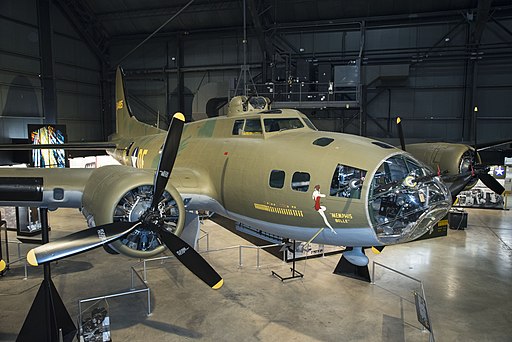When you picture the B-17, you can’t help but imagine its distinct four-engine structure soaring gracefully against a backdrop of bright blue skies or a blazing sunset. It’s not just a sight remembered by those who’ve studied World War II; it’s an image that’s become a staple in our pop culture psyche.
The B-17, aptly nicknamed the Flying Fortress, wasn’t just any plane during WWII. It was at the heart of many critical bombing missions across Europe. The plane’s endurance, fortitude, and capacity to withstand significant damage earned it respect and admiration. As it hurtled through European skies, dropping payloads over German-controlled regions, it was also weaving its legacy into history.
Cinematic Triumphs
The most significant reflection of the B-17’s place in popular culture is in cinema. Films have a knack for capturing the zeitgeist of a period, translating it into moving images that speak volumes. Twelve O’Clock High (1949) is a prime example, offering a profound, almost intimate portrayal of the men of the Eighth Air Force who flew B-17s during the war. With Gregory Peck at the helm, the film gave audiences a raw, unfiltered look into the challenges and psyche of aircrews. Such was its impact that it became mandatory viewing at U.S. service academies for lessons in leadership.
Then there’s the visually striking Memphis Belle (1990), which chronicles the final mission of one of the first B-17 bombers to complete 25 missions in the European theater. Through a mélange of tense airborne sequences and human drama, the movie underscored the bravery of the young men aboard these aircraft.
Literature’s Ode to the Skies
With its infinite scope for nuanced detailing, the written word hasn’t been far behind in honoring the B-17. Novels such as “The Wild Blue” by Stephen Ambrose provide detailed accounts of B-17 missions, juxtaposed against the broader canvas of the U.S. Army Air Force’s role in the war. Such narratives don’t merely chronicle events; they bring alive the sweat, fear, and hope that permeated every rivet and bolt of the B-17.
Music and the Roar of Engines
Even music, the abstract medium of emotions, has played its part. Hard rock band Pink Floyd’s “Learning to Fly”, while not directly about the B-17, captures the essence and allure of flying, reminiscent of the emotions a B-17 pilot might have felt soaring over war-torn landscapes.
Beyond Entertainment
Outside of these popular culture mediums, the B-17 remains a fixture in airshows, museums, and memorials. Its presence is a tangible link to history, allowing newer generations to touch, feel, and sometimes even fly in a machine that once was pivotal in shaping world events.
The B-17’s transition from a wartime marvel to a symbol of perseverance, courage, and technological innovation in popular culture underscores the plane’s impact. It is not merely a flying machine but a testament to human endeavor, a symbol of hope and sacrifice, and a beacon from an era where the very fate of the world hung in the balance.
From the silver screens of Hollywood to the pages of riveting novels and the electrifying chords of rock anthems, the B-17 Flying Fortress has transcended its metallic frame to become an enduring icon, a representative of a time and spirit that continues to inspire and captivate.
For more insights into the B-17F Flying Fortress and other important military aircraft, visit Aces In Action. Here, you’ll find an amazing piece of artwork by Craig Tinder titled “The Last of the First – Memphis Belle,” which illustrates the historic take-off on 19 May 1943 when the famous B-17F Flying Fortress “Memphis Belle” departed on her 25th and final mission. The limited edition canvas print even includes a piece of the “Memphis Belle” originated during an early restoration effort in 1987-88 when the “Belle” was located in Mud Island in Memphis, Tennessee., making it a unique piece of history!
The Last of the First – Memphis Belle Aviation Art by Artist Craig Tinder
19 May 1943 – The “Memphis Belle” lifts off from RAF Bassingbourn on her 25th and final mission. The “Belle” and her crew became the first to complete 25 missions over Europe and return to the U.S. Her final mission was piloted by Lt. C.L. Anderson as her original crew, led by Capt. Robert K. Morgan, had already completed their 25th mission and were headed back to the U.S. to begin their publicized War Bond Tour.





Share:
Famous B-25 Squadrons and their Missions: An Aerial Journey Through History
The Black Cats: Night Predators of the Pacific Theater